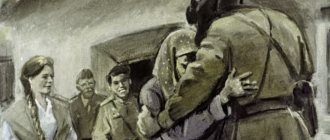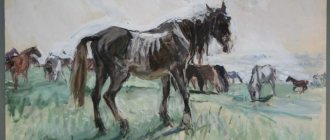The Sandy Teacher - a summary of Platonov's story
Masha Naryshkina grew up as a strong, healthy girl in a town surrounded by desert.
War and revolution passed her by; her father did not tell the girl about these events. She loved the desert, she loved geography, she read her father's books. When the girl turned sixteen, her father took her to pedagogy courses. The time has come for her youth, the most defenseless and difficult time in a person’s life. There were times when Masha loved and when she wanted to kill herself. And now, finally, the time for studying is over. At the age of twenty, Maria completed the course and was sent to a remote village near the desert. It was there that Masha saw a real desert storm for the first time in her life. It happened on the way to the village. Maria arrived three days later. The entire village consisted of several dozen courtyards and was covered with sand. Masha realized that people were doing difficult but completely useless work here, clearing the streets of embankments, because the wind brought sand again and again, and the streets were again completely covered with sand.
Maria began to live in rooms at the school. The watchman, who had lived alone for a long time, was very happy with her and began to help arrange the girl’s home. Two months later, having finished preparing the school to receive children, Maria began teaching children. Children who were not used to attending classes attended lessons in varying numbers.
Winter came. The village began to run out of bread, and children, suffering from cold and hunger, stopped being interested in studying and coming to school. During the winter, several children died from terrible living conditions. Realizing that it was impossible to teach children in this situation, Maria realized that sand fighting should be taught at school. She went to the district to tell about her intention. They were not sent a special teacher, but they were given books and told the girl to teach it herself.
In two years, Maria managed to turn the desert into a green place. People began to develop the village, protecting it from the sand, and in the desert they learned to plant some cereals. Within two years the village had completely changed and became livable. Now not only children, but also adults came to school. They all listened to Mary's lessons on survival in the desert. Maria gained weight and became even healthier, despite the huge amount of worries that fell on her shoulders.
In the third year, disaster struck. Every fifteen years, nomads came past the village. They were supposed to appear in the spring, when there was still grass, but they were late. Maria didn’t understand well what was going on, so she just waited. The entire desert has already died out. And finally, the nomads arrived. Their horses gnawed and destroyed everything that the peasants had worked on in the village for these three years, destroying all the greenery. Angry, Maria went to the nomads, but they said that they did not do this out of malice, there was simply very little grass and someone was always forced to suffer.
Maria decided to complain to the district, but there they told her to transfer to another village where settled nomads lived. They say that when they learn to cultivate the land, they will stop making such raids on other villages. And Maria agreed.
Also read:
The story of The Sandy Teacher
Popular retellings today
The talented writer Nosov E.I. was born in the village. Tolmachevo (Kursk region) in 1925 on January 15. A quiet village located near the Seim River. The father of the future writer is a hereditary artisan
The work, which is called “Through the Eyes of a Clown,” was written by the brilliant German writer Heinrich Bell and is incredibly popular among literature lovers to this day.
Emile Zola was born in Paris on April 2, 1840. He was born in a mixed marriage of an Italian and a French woman. His father was not married until he was 45, he traveled around the world, and after meeting a young beauty, he settled down
The action of the work takes place in the autumn of 1819 in the Vauquer boarding house. There are 7 residents living here who are contemptuous of Father Goriot, who, in their opinion, occupied the best room several years ago.
Summary of Platonov The Sandy Teacher
Naryshkina Maria Nikiforovna grew up in the family of a teacher. Maria followed in her father's footsteps and also received a pedagogical education. The girl was sent to practice as a teacher in a school in the village of Khoshutovo. The village was remote, located next to the Astrakhan desert. It is not surprising that the village often suffered from the consequences of sandstorms - every day the residents cleared the streets of sand. The peasants could not work, there was no harvest.
Due to poverty and problems with sand, children often got sick, so they missed school and had no desire to study. However, Maria Nikiforovna does not lose heart. The teacher also decided to fight the sand problem. She sought help from the education department, but they could not help her because there were no specialists on this problem. Instead of help, Maria Nikiforovna was given books describing methods of combating sand deposits. Having studied the relevant literature, she gets down to business: she carries out annual landscaping work, convincing residents of the need for this measure. This partially helps to overcome the problem of the village of Khoshutovo - planted shrubs protected the crops from sand.
Schoolchildren are more willing to go to school, and not only them - adults also began to appear at school in order to learn how to live more fully near the dead desert. But soon a new misfortune comes: nomads settle not far from Khoshutovo. The economic activity of nomads destroys planted plants and depletes water supplies in wells; their horses trample the greenery. There are crop failures in the village again. The teacher is trying to cope with this problem: she goes to the leader of the nomadic tribe and asks to stop ruining the village, to treat the planted plants and available water sources with care. The leader agrees and asks Maria to teach the nomads to live the same way as they live in Khoshutovo.
The Khoshut people no longer need Maria: they cope with the sands without her. They decided to transfer Maria to another village, where they also need help in fighting the sands. Like many girls, she had a dream of meeting her beloved and getting married, but in the wilderness where she was sent this was hardly possible. But Maria decides to devote herself to helping others and continues to green the desert in different villages.
Maria's story is a shining example of enthusiasm and dedication. She struggled with the problem, no matter what, gave up her personal life in order to help the whole people. Her desire to change the world around her for the future of many people is commendable.
Summary of Platonov's sandy teacher for a reader's diary
Year: 1927 Genre: story
Main characters: Maria Naryshkina
The young teacher Maria Nikiforovna is hired to work in a village near the desert. She is forced to fight the sands to win the favor of the residents. The results of her work do not wait long. The leader of the neighboring village also turns to her for help. The goal of Maria's whole life is to fight the sands of the desert.
Basic meaning. Purposeful steps will certainly lead to the goal. The main thing is to believe in yourself and fully devote yourself to the task. Nothing can stop such a person from achieving his goal.
Summary of Platonov – The Sandy Teacher
Maria Nikiforovna spent her happy childhood in her home. Her father was a teacher and in a loving way wanted to make his daughter happy. Having matured, Maria studied to become a teacher and finally entered adult life. She becomes a teacher in the village of Khoshutovo. Near the village there is a Central Asian desert. The only task of the villagers was to fight against the endless sands of the desert.
All of the village's land was covered with sand, making the villagers' task even more difficult. Because of this problem, none of the children have the desire to come to school and study. Maria Nikiforovna puts all her strength into the fight against the sands. She asks agronomists for help. They refuse to help her. In return, they give special literature that describes ways to fight against the desert. She decides to handle the task on her own. He studies many books on this topic and organizes planting of green plants and a pine nursery. These steps significantly improve the condition of the village and force residents to look at the young teacher with different eyes.
Schools are already filled with students of all ages eager to learn. This action of the teacher's steps soon loses its impact. After some time the situation changes. Nomads move into the village. Their actions were devastating for the village. They destroyed all the greenery and completely exhausted the water in the wells. Maria is ready to take any steps, just to preserve the result of her labors. She decides to go to the leader of the tribe and ask him to stop destroying and destroying the village, not to destroy the ancient green plantings and not to waste too much water. The leader asks the teacher to teach the residents of the village of Safuta to live like the residents of Khoshutovo.
The teacher agrees to teach them how to grow greens in her village. She decides to devote herself entirely to the cause and rid the residents of both villages of the sands. Maria promises all village residents to grow a real forest in place of the desert.
Read the summary of The Sandy Teacher. Brief retelling. For a reader's diary, take 5-6 sentences
Platonov. Brief summaries of works
Other retellings and reviews for the reader's diary
A young merchant named Krasilnikov is riding along the road in a chaise. A hunting dog runs next to the horse. Krasilnikov is a graduate of Moscow University, lives in Moscow, and owns an estate in the Tula province
The main narrator in the work is Death. The character is terribly tired of his work, since World War II begins and there is really a lot of work. Death watches Liesel's life closely.
And again, Hercule Poirot is a magnificent detective, the hero of Agatha Christie’s novels from the “Oriental” cycle. This time the detective finds himself on the steamship Karnak, sailing along the Nile River with careless and noisy passengers.
The story begins with the statement that we divide all people into “strangers and our own.” How? We just know about “our own” people, how old they are and how much money they have. People always try to hide these things and concepts that are most important to people.
The work is an author's research containing several life concepts regarding human self-development and managing one's own life, presented in the form of a fable.
Reader's diary based on the story “The Sandy Teacher” by Platonov
Plot
A young teacher from the Astrakhan province, Maria Nikiforovna Naryshkina, travels to a poor village on the sands of Khoshutovo. Maria begins to fight the sand. Peasants plant bushes (shelyuga) and pine trees to protect their crops from dryness and wind. The crops are growing, but all the greenery is eaten by the nomadic cattle. However, people already know what to do with sand. Maria is called to the village of Safuta: to teach nomads to live like a peasant. She feels sorry for people - she’s going.
Review
The title of the story is the fate of a young selfless teacher. She comes from a teaching dynasty (her father is a teacher). She grew up among the sands, and her calling became the fight against them. Maria is a happy person. Her meaning in life is to help people. She does not regret that youth is passing by, that she does not yet have a family. Her family is two peoples in a hungry steppe. The theme of young enthusiasts who work for the benefit of people, the fight against nature, poverty, ignorance. Maria dreams that survival will be replaced by life. The story teaches us to set noble goals for ourselves, to think not only about ourselves, but also about others, self-sacrifice, selflessness, and courage.
Source
Sandy teacher
Very briefly
A geography teacher teaches people to fight the sands and survive in the harsh desert.
Twenty-year-old Maria Nikiforovna Naryshkina, the daughter of a teacher, “originally from a sand-covered town in the Astrakhan province” looked like a healthy young man “with strong muscles and firm legs.” Naryshkina owed her health not only to good heredity, but also to the fact that her father protected her from the horrors of the Civil War.
Since childhood, Maria was interested in geography. At the age of sixteen, her father took her to Astrakhan for pedagogical courses. Maria studied at the course for four years, during which her femininity and consciousness blossomed and her attitude towards life was determined.
Maria Nikiforovna was assigned as a teacher to the remote village of Khoshutovo, which was “on the border with the dead Central Asian desert.” On the way to the village, Maria saw a sandstorm for the first time.
The village of Khoshutovo, where Naryshkina reached on the third day, was completely covered with sand. Every day the peasants did hard and almost unnecessary work - they cleared the village of sand, but the cleared places fell asleep again. The villagers were immersed "in silent poverty and humble despair."
The tired, hungry peasant raged many times and worked wildly, but the forces of the desert broke him, and he lost heart, waiting either for someone’s miraculous help or for resettlement to the wet northern lands.
Maria Nikiforovna settled in a room at the school, ordered everything she needed from the city and began teaching. The students walked erratically - then five would come, then all twenty would come. With the onset of severe winter, the school was completely empty. “The peasants were saddened by poverty,” they were running out of bread. By the New Year, two of Naryshkina’s students had died.
Maria Nikiforovna’s strong nature “began to get lost and fade away” - she did not know what to do in this village. It was impossible to teach hungry and sick children, and the peasants were indifferent to the school - it was too far from the “local peasant business.”
The young teacher came up with the idea that people should be taught how to fight sand. With this idea, she went to the department of public education, where they treated her sympathetically, but they did not give her a special teacher, they only provided her with books and “advised her to teach sand business herself.”
Upon returning, Naryshkina, with great difficulty, persuaded the peasants to “arrange voluntary public works every year - a month in the spring and a month in the fall.” In just a year, Khoshutovo has been transformed. Under the guidance of the “sand teacher,” the only plant that grows well on these soils was planted everywhere - the shelyuga shrub, which looks like a willow.
Strips of shelyug strengthened the sands, protected the village from desert winds, increased the yield of herbs and made it possible to irrigate vegetable gardens. Now the residents heated their stoves with bushes, and not with stinking dry manure; they began to weave baskets and even furniture from its branches, which provided additional income.
A little later, Naryshkina took out pine seedlings and planted two strips of plantings, which protected the crops even better than shrubs. Not only children, but also adults began to go to Maria Nikiforovna’s school, learning “the wisdom of life in the sandy steppe.”
In the third year, disaster struck the village. Every fifteen years, nomads passed through the village “along their nomadic ring” and collected what the rested steppe gave birth to.
The windless steppe at that hour smoked on the horizon: thousands of nomadic horses galloped and their herds trampled.
Three days later, nothing remained of the peasants’ three-year labor—everything was destroyed and trampled by the horses and cattle of the nomads, and people drained the wells to the bottom.
The young teacher went to the leader of the nomads. He listened to her silently and politely and replied that the nomads were not evil, but “there is little grass, a lot of people and livestock.” If there are more people in Khoshutovo, they will drive the nomads “to the steppe to their death, and this will be as fair as it is now.”
He who is hungry and eats the grass of his homeland is not a criminal.
Secretly appreciating the wisdom of the leader, Naryshkina went to the district with a detailed report, but there she was told that Khoshutovo would now manage without her. The population already knows how to fight the sands and, after the nomads leave, will be able to further revitalize the desert.
The manager suggested that Maria Nikiforovna transfer to Safuta - a village inhabited by nomads who had switched to a sedentary lifestyle - in order to teach local residents the science of survival among the sands. By teaching the residents of Safuta the “culture of the sands,” you can improve their lives and attract other nomads, who will also settle down and stop destroying the plantings around Russian villages.
The teacher felt sorry for spending her youth in such a wilderness, burying her dreams of a life partner, but she remembered the hopeless fate of the two peoples and agreed. At parting, Naryshkina promised to come in fifty years, but not along the sand, but along a forest road.
Saying goodbye to Naryshkina, the surprised head said that she could manage not a school, but an entire people. He felt sorry for the girl and for some reason ashamed, “but the desert is the future world, ‹…› and people will be noble when a tree grows in the desert.”
School reading
Works of school literature in a simple and accessible form
Site content
08.07.2019
Platonov A. “Sandy Teacher”
The main characters of the story “The Sandy Teacher” and their characteristics
- Maria Nikiforovna Naryshkina. A young teacher, an active, responsible person.
Plan for retelling the story “The Sandy Teacher”
- Early life and studies
- In the village of Khoshutovo
- Sand control plan
- Successes of the struggle
- Invasion of nomads
- Everything is lost
- New appointment
- Teacher's Promise
The shortest summary of the story “The Sandy Teacher” for a reader’s diary in 6 sentences
- After completing the courses, Maria goes to Khoshutovo, where she sees poverty and advancing sands.
- She decides to train people to fight the sands.
- Maria plants protective plantings and pine trees.
- Nomads come and destroy all the plants.
- Maria complains to the district, but they offer her a new village and continued work.
- Maria agrees and promises to turn the desert into a forest.
The main idea of the story “The Sandy Teacher”
Man can turn the desert into a blooming garden.
What does the story “The Sandy Teacher” teach?
The story teaches perseverance, dedication, and the ability to captivate people. Teaches you to fight difficulties, not give up, and live for people.
Review of the story “The Sandy Teacher”
I liked this story, although I feel a little sorry for the teacher who will devote her whole life to fighting the sands, forgetting about her personal life. But she chose a different happiness for herself - serving people.
Proverbs for the story “The Sandy Teacher”
Persistence and work will grind everything down. Live for people, people will live for you. Man is the architect of his own happiness. Live not for the past, but for tomorrow. Life is not beautiful in days, but in deeds.
Read the summary, a brief retelling of the story “The Sand Teacher” chapter by chapter:
Maria Naryshkina was 20 years old and came from a small town in the Astrakhan province. She was spared the events of war and revolution, and she grew up when socialism had already become stronger. She loved geography, enthusiastically read her father's books and entered pedagogical courses. After four years of study, Maria was assigned to the village of Khoshutovo, near the desert.
On the way to the village, Maria saw a sandstorm for the first time, and the village itself struck her with its poverty. Khoshutovo was almost all covered with sand, there were several courtyards in it, and Maria settled in a room at the school. The old watchman accepted her as a daughter.
Classes began two months later, but the children went to school irregularly. And when early winter came, they almost stopped altogether. They had nothing to wear, they were starving, just like the adults. By the New Year, two children had died. Maria decided to start teaching people how to deal with the sands, how to make living land out of the desert. The peasants did not believe the teacher, but those in the area sympathized with her and gave her books. The agronomist lived one and a half hundred miles away and had never been to Khoshutovo.
By the end of the first summer, Maria convinced the peasants to do public works in the spring and autumn, and a year later Khoshutovo was unrecognizable. Around the village, protective shelve strips of landscaping appeared to protect the irrigated vegetable gardens. Maria Nikiforovna was going to set up a pine nursery near the school and finally conquer the desert. She knew that plants planted between the pines gave double yields. Fuel appeared in Khoshutovo, and they began to weave baskets and make furniture from twigs. This brought the village two thousand rubles in profit. Now the school was filled not only with children, but also with adults.
Three years later, disaster struck; nomads passed through the village. They were late, the steppe had already died, and the nomads fed their cattle on plantations and pine trees. The water disappeared because the cattle drank it clean. Enraged, Maria went to the leader of the nomads and began to swear. She said that she would complain and that now it was Soviet power. But the leader replied that the one who is hungry and eats the grass of his homeland is not a criminal. Maria went to the district, and there they said that Khoshutovo will now manage without her, the peasants know what to do. And they suggested that the teacher do the same work in Safuta, a village where former nomads settled. There, too, it was necessary to train people to fight the sands, because the more nomads begin to lead a settled life, the less often they will destroy plantings in other villages. Maria thought about her youth, her non-existent husband, the leader of the nomads and agreed. She promised to return in fifty years as an old woman, but along a forest road.
“The Sandy Teacher”, analysis of Platonov’s story
History of creation
The story “The Sandy Teacher” was written by Platonov in 1926 and published in the collection “Epiphanian Gateways” (1927), as well as in the newspaper “Literary Environments” No. 21 for 1927. The prototype of Maria Naryshkina was Platonov’s wife Maria Kashintseva. In 1921, Platonov’s bride eliminated illiteracy in a village 60 km from Voronezh, running away from her relationship with her future husband.
In 1931, the film “Aina” was created based on the story.
Literary direction and genre
The work belongs to the direction of realism. In the second edition, Platonov worked precisely on a realistic explanation of how the Russians appeared in Khoshutov. He calls them settlers, suggesting that they could have settled there during the period of Stolypin's agrarian reform. For realism, Platonov changes the interval of appearance of nomads from 5 years to 15, but the settlement could hardly have arisen and stayed on the path of the nomads.
Another thing is the story of the taming of the sands. Indeed, there are known cases when villages and villages were resettled due to advancing sands. Platonov in his white autograph defines the genre of the work as an essay, since it conveys practical knowledge for fighting the sands. The story forms the plot of an entire educational novel, telling about the formation of the hero.
Topic and issues
The theme of the story is the formation of personality, the problem of choice. The main idea is that to achieve life goals you need not only determination, but also wisdom and humility in the face of life's circumstances. In addition, in Chapter 5 Platonov solves the philosophical question of the coexistence of two ways of life - sedentary and nomadic. The heroine understands the plan of the Soviet employee and voluntarily, even joyfully, accepts the lifelong role of a sandy teacher.
Social problems are also raised related to the disregard of the authorities for people (Maria is listened to politely, shakes hands as a sign of the end of the conversation, but helps only with advice). But they ask you to devote your whole life to a public cause. The philosophical problems of sacrifice and retribution, gratitude, inspiration, wisdom and short-sightedness are relevant in the story.
Plot and composition
The short story consists of 5 chapters. The first chapter retrospectively mentions the main character’s childhood and studies and characterizes her father. The present in the story begins with the fact that the young teacher Maria Nikiforovna Naryshkina is sent to the distant village of Khoshutovo on the border with the Central Asian desert. The second part is about how, 3 days later, having arrived in a small village, Maria Naryshkina was faced with the meaningless hard work of the peasants who were clearing the courtyards that were again covered with sand.
The third part is about trying to teach literacy to children. The peasants were so poor that the children had nothing to wear; they were starving. When two children died in winter, the teacher guessed that the peasants did not need any science other than the science of fighting the sands and conquering the desert.
Maria Nikiforovna turned to the district with a request to send a sand science teacher. But she was advised to teach the peasants herself with the help of books.
The fourth part tells how the village has changed in 2 years. Only six months later, the peasants agreed to do public works for landscaping Khoshutov twice a year for a month. After 2 years, the shelyuga (a half-meter-tall shrub of the red shrub) was already protecting vegetable gardens and wells, and pine trees were growing in the village.
The last part is the climax. After 3 years, all the fruits of the labor of the teacher and peasants were destroyed. When the nomads passed through the village (which happened every 15 years), their animals gnawed and trampled the plants, drank water from the wells, the teacher went to the leader of the nomads, then to the district with a report. Zavokrono suggested that Maria Nikiforovna go to the even more distant village of Safutu, where settled nomads lived, in order to teach them how to fight the sands. Maria Nikiforovna resigned herself and agreed.
Thus, compositionally, the story is divided into several stages in the process of personality development: study and dreams about the future use of one’s skills, a difficult start to activity, success, disappointment and disappointment, awareness through sacrifice of one’s true destiny and humble acceptance of one’s own fate.
Heroes and images
The main character is Maria Naryshkina, who is described in the second sentence in the masculine gender: “He was a young, healthy man.” The heroine's appearance emphasizes her resemblance to a young man, strong muscles and solid legs. That is, the heroine is strong and resilient. The author seems to be specially preparing her for physical tests.
Maria experiences mental suffering while studying at pedagogical courses, from 16 to 20 years old, when “both love and a thirst for suicide” happened in her life. These shocks prepared her for an independent life in a distant village on the border with the desert. Self-confidence and a calm character were brought up by my father, who did not explain the events of the revolution and civil war.
Maria also fell in love with her desert homeland from childhood, and learned to see its poetry, similar to the tales of the Arabian Nights: tanned merchants, camel caravans, distant Persia and the Pamir plateaus, from where the sand flew.
For the first time, Maria encountered the elements of the killing desert on the road to Khoshutovo, having survived a sandstorm. The forces of the desert did not break the young teacher as they did the peasants. The death of two out of 20 students from hunger and disease made Naryshkina think. Her “strong, cheerful and courageous nature” found a way out: she learned the sand business herself and taught others.
For the peasants, the teacher became almost a god. She even had “prophets of the new faith” and many friends.
The first sadness in the teacher’s life was associated with the collapse of her new faith in victory over the elements. The new element - the hunger of the nomadic tribes - also did not break the girl. She knows how to objectively judge people. Both the leader’s answer and the answer turned out to be wise, which at first seemed unreasonable to the girl.
Maria Naryshkina’s choice to go to an even greater wilderness is not a sacrifice, as a result of which Maria allowed herself to be buried in the sands, but a conscious life goal. The leader of the nomads in the story is contrasted with Zavokrono. The leader is wise, he understands the hopelessness of the struggle of nomads with sedentary Russians for grass. Zavokrono at first seems narrow-minded to Maria, but then she catches his precise calculation: when the nomads switch to a sedentary lifestyle, they will stop destroying the greenery in the villages.
The story shows how myth and fairy tale shape a person’s personality, and a person then transforms space, turning it into a fairy tale. Geography, a story about distant countries, was the heroine's poetry. The thirst for conquering space, mixed with love for her homeland, prompted Maria to go to remote villages to make the myth of the green spaces of the former desert come true.
Artistic originality
The story contrasts the deadness of the Central Asian desert and the liveliness of the heroine herself and her ideas of landscaping, “the art of turning the desert into living land.” The dead are conveyed by metaphorical epithets and metaphors: deserted sands, sandy shifting graves, a hot wind for dead children, the steppe has been extorted from itself, the steppe has long since died, a half-dead tree.
At the climactic moment of decision-making, Maria Naryshkina sees her youth buried in the sandy desert, and herself dead in the shell bush. But she replaces this dead picture with a living picture, imagining herself as an old woman driving along a forest road from the former desert.
Landscapes in the story form an important part of the idea, realizing the antithesis of the living and the dead.
The short story is full of aphorisms: “Someday youth will not be defenseless,” “Someone dies and swears,” “Whoever is hungry and eats the grass of his homeland is not a criminal.”
A. Platonov “The Sandy Teacher”: summary, main characters, problems, reviews
Andrei Platonovich Platonov lived a rich, meaningful life. He was an excellent engineer and worked hard to benefit the young socialist republic. First of all, the author was remembered for his short prose. In it, Platonov tried to convey to readers the ideals to which society should strive. The embodiment of bright ideas was the heroine of Platonov’s story “The Sandy Teacher”. With this female image, the author touched on the topic of giving up personal life for the sake of public affairs.
The prototype of Plato's teacher
Platonov’s story “The Sandy Teacher,” a summary of which you can read below, was written in 1927. Now mentally transport yourself to the 20s of the last century. Post-revolutionary life, building a big country.
Literary researchers believe that the prototype of the main character of Platonov’s story “The First Teacher” was the author’s fiancée, Maria Kashintseva. One day, as a student internship, a girl went to a village to fight illiteracy. This mission was very noble. Maria was also afraid of Andrei Platonovich’s too intense feelings and courtship, so she made a kind of escape into the outback. The writer dedicated many touching lines to his beloved in his stories and stories.
Storyline of the story
“The Sand Teacher,” a summary of which we provide, takes the reader to the Central Asian desert. Do you think it's a coincidence? Western European experts believe that desert conditions reveal the strongest human traits. Biblical tradition says that Christ wandered in the desert for 40 days, did not eat or drink anything, and strengthened his spirit.
Maria Naryshkina had a wonderful childhood with wonderful parents. Her father was a very wise man. While working as a teacher, he did a lot for his daughter’s development. Then Maria studied at pedagogical courses in Astrakhan. After graduation, she is sent to the remote village of Khoshutovo, which is near the desert in Central Asia. The sands made life very difficult for local residents. They could not engage in farming, they had already given up and abandoned all their endeavors. Nobody even wanted to go to school.
The energetic teacher did not give up, but organized a real battle with the elements. After consulting with agronomists in the regional center, Maria Nikiforovna organized the planting of shellweed and pine. These actions made the desert more welcoming. Residents respected Maria, students came to school. Only soon the miracle ended.
Soon the village was raided by nomads. They destroyed the plantings and used water from wells. The teacher is trying to negotiate with the leader of the nomads. He asks Maria to teach forestry to the residents of a neighboring village. The teacher agrees and decides to devote herself to saving villages from the sands. She encourages the residents and believes that someday there will be forest plantations here.
The image of a teacher - a conqueror of nature
A. S. Pushkin wrote: “We will reward our mentors for their blessings.” The main character in the book “The Sand Teacher” can be called a mentor, and not a teacher. The summary does not convey the ruthlessness and coldness of the desert towards people. Only a purposeful person with an active life position can resist it. In her actions, Maria Nikiforovna uses humanity, justice, and tolerance. The teacher does not shift the fate of the peasants onto anyone and is optimistic about the future. Once upon a time she dreams of coming to the village along a forest road.
Themes, issues and values raised by the author
The main characters of “The Sand Teacher” served Platonov to convey the main idea - the value of knowledge for villagers and entire nations. Maria proudly carries out her main mission - to give knowledge. For the residents of the village of Khoshutovo, the most important thing was to plant plants, strengthening the soil and creating forest belts.
The characters in the story hardly communicate; this style of storytelling can be called reportage. The author only narrates and describes the actions. The feelings of the characters are conveyed by Platonov very emotionally. The story contains many metaphors and colorful expressions.
The theme of cultural exchange is central to the book. The author proclaims special values - friendly relations and finding a common language with various figures, even with nomads.
Reviews of “The Sandy Teacher”
Many readers compare Platonov’s story with Kobo Abe’s novel “The Woman in the Sands.” There, the woman also struggles with the sandy desert, but then resigns herself and settles down. And Platonov’s heroine strives with all her might to defeat a natural phenomenon. Some school curricula include the story “The Sandy Teacher” for study in the 6th grade. It wouldn’t hurt for students to read the summary. Children in class ask themselves the question: “How to save the results of their work?”
Readers note that the story teaches us to lend a helping hand to those around us. Not everyone can give up their personal life for the sake of a common cause. The teacher gave the most important thing to the desert - her youth, but the fate of entire nations worries her more.
Other retellings and reviews for the reader's diary
Sonya, the main character of the work, was not distinguished by either great intelligence or beauty. People around them often took advantage of this and asked the girl to either babysit the children, or help in the kitchen, or hem something
This work is about the heroic deed of a young guy. The police and firefighters, and all concerned people, were busy searching for the young man.
Pugachev was a peasant and warrior who always dreamed of freedom. He wanders the earth for a long time and as a result comes to Yaik, where he meets a local man, from whom he learns that the people here are expecting the appearance of a new king
The events of the novel take place in frosty December 1918. The Turbinnykh's mother dies. Alexey, Lena and Nikolka are grieving the loss of a loved one.
Life in an army regiment goes on as usual. The boring life of the officers ends when they meet Silvio.
Source








